

Champions for Change Calgary. CHAMPIONS FOR CHANGE:Leading a Backbone Organization for Collective Impact April 15-17, 2015 Join together with the Tamarack Institute, the Collective Impact Forum, and Backbone organizations from across North America and internationally, to enhance your work in leading for Collective Impact.
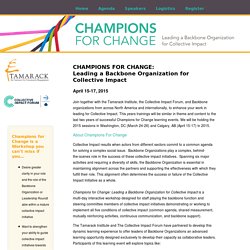
This years trainings will be similar in theme and content to the last two years of successful Champions for Change learning events. We will be holding the 2015 sessions in Washington, DC (March 24-26) and Calgary, AB (April 15-17) in 2015. About Champions For Change Collective Impact results when actors from different sectors commit to a common agenda for solving a complex social issue. The Tamarack Institute and The Collective Impact Forum have partnered to develop this dynamic learning experience to offer leaders of Backbone Organizations an advanced learning opportunity designed exclusively to develop their capacity as collaborative leaders. Collective Impact Forum. Findings from a national study The five conditions for collective impact offer guidance not only for collective impact initiatives but for other forms of collaboration as well.
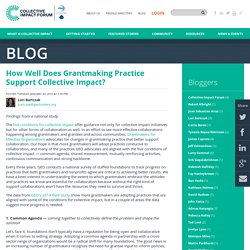
In an effort to see more effective collaborations happening among grantmakers and grantees and across communities, Grantmakers for Effective Organizations advocates for changes in grantmaking practice that better support collaboration. Our hope is that more grantmakers will adopt practices conducive to collaboration, and many of the practices GEO advocates are aligned with the five conditions of collective impact — common agenda, shared measurement, mutually reinforcing activities, continuous communication and strong backbone. Every three years, GEO conducts a national survey of staffed foundations to track progress on practices that both grantmakers and nonprofits agree are critical to achieving better results. 1. 2. 3. 4. 5.
Collective Impact Forum. Investing in Change: Funding Collective Impact Efforts - 43519. Leadership and Networks Wiki Resources. White House Council for Community Solutions. The White House Council for Community Solutions conducted extensive research and outreach to learn about community collaboration and pathways to employment for youth.
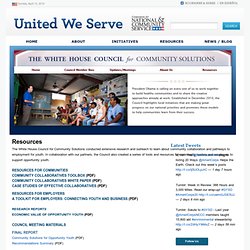
In collaboration with our partners, the Council also created a series of tools and resources for community leaders and employers to support opportunity youth. Resources for CommunitiesCommunity Collaboratives Toolbox (PDF) Community Collaboratives White Paper (PDF) Case Studies of Effective Collaboratives (PDF) Resources for EmployersA Toolkit for Employers: Connecting Youth and Business (PDF) Research ReportsEconomic Value of Opportunity Youth (PDF) Council Meeting Materials Final Report. Report - Needle-Moving Community Collaboratives: A Promising Approach to Addressing America’s Biggest Challenges. Download PDF Author(s): Willa Seldon, Michele Jolin, Paul Schmitz Published Date: February 06, 2012 Executive Summary Communities face powerful challenges—a high-school dropout epidemic, youth unemployment, teen pregnancy—that require powerful solutions.

In a climate of increasingly constrained resources, those solutions must help communities to achieve more with less. In December 2010, President Obama created the White House Council for Community Solutions to demonstrate the power of engaging “all citizens, all sectors working together.” The Council worked with The Bridgespan Group to identify effective needle-moving collaboratives (those that have achieved at least 10 percent progress in a community-wide metric), understand the keys to success, and recommend ways to drive more collective impact, particularly to address the challenges of disconnected youth. Looking deeper, we discovered five core elements that contributed to their success: Other Popular Articles on Bridgespan.org.
Collective Impact. (Photo by iStock/wildpixel) The scale and complexity of the US public education system has thwarted attempted reforms for decades.
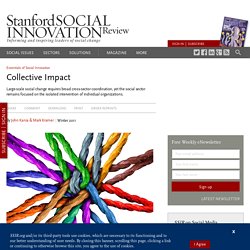
Major funders, such as the Annenberg Foundation, Ford Foundation, and Pew Charitable Trusts have abandoned many of their efforts in frustration after acknowledging their lack of progress. Once the global leader—after World War II the United States had the highest high school graduation rate in the world—the country now ranks 18th among the top 24 industrialized nations, with more than 1 million secondary school students dropping out every year. The heroic efforts of countless teachers, administrators, and nonprofits, together with billions of dollars in charitable contributions, may have led to important improvements in individual schools and classrooms, yet system-wide progress has seemed virtually unobtainable. Channeling Change: Making Collective Impact Work.
This follow-up on the popular "Collective Impact" article provides updated, in-depth guidance.
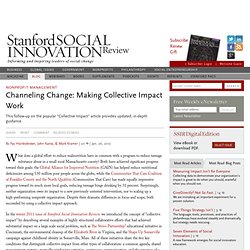
What does a global effort to reduce malnutrition have in common with a program to reduce teenage substance abuse in a small rural Massachusetts county? Both have achieved significant progress toward their goals: the Global Alliance for Improved Nutrition (GAIN) has helped reduce nutritional deficiencies among 530 million poor people across the globe, while the Communities That Care Coalition of Franklin County and the North Quabbin (Communities That Care) has made equally impressive progress toward its much more local goals, reducing teenage binge drinking by 31 percent. Surprisingly, neither organization owes its impact to a new previously untested intervention, nor to scaling up a high-performing nonprofit organization. Despite their dramatic differences in focus and scope, both succeeded by using a collective impact approach. Response to that article was overwhelming. Creating Boundaries. A Unified Theory of Social Change - Dan Pallotta.
By Dan Pallotta | 3:15 PM March 8, 2012 Most conversations about changing the world eventually degenerate into despair or, after a hands-in-the-air “well, anyway…” segue, they lapse into a conversation about something more practical or pressing.
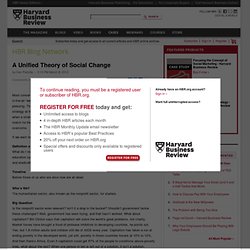
That’s because most discussions related to big change are about tactics rather than strategy at the scale of the question — and nothing’s more depressing than a tactical discussion when a strategic one is required. It creates the illusion of impossibility; makes us feel like we’re no match for the huge social challenges facing us. We start to doubt that they can actually be overcome. If we want to change the world, we need a strategic plan. Definition of Terms What do I mean by changing the world? Timeline Before those of us who are alive now are all dead. Big Question Is the nonprofit sector even relevant? AIDS and poverty are the tip of the iceberg.